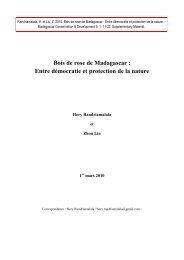Journal Madagascar Conservation - Madagascar Wildlife ...
Journal Madagascar Conservation - Madagascar Wildlife ...
Journal Madagascar Conservation - Madagascar Wildlife ...
You also want an ePaper? Increase the reach of your titles
YUMPU automatically turns print PDFs into web optimized ePapers that Google loves.
MADAGASCAR CONSERVATION & DEVELOPMENT VOLUME 3 | ISSUE 1 — DECEMBER 2008 PAGE 31<br />
Discovery of Macrotarsomys bastardi at Beza<br />
Mahafaly Special Reserve, southwest <strong>Madagascar</strong>,<br />
with observations on the dynamics of small<br />
mammal interactions<br />
Ibrahim Antho Youssouf Jack I* and<br />
Emilienne Rasoazanabary *<br />
ABSTRACT<br />
We report the presence of Macrotarsomys bastardi, Bastard’s<br />
big - footed mouse, at the Beza Mahafaly Special Reserve in<br />
southwestern <strong>Madagascar</strong>. Despite years of fieldwork, including<br />
field research targeting the nocturnal mammals, this species had<br />
never been reported here previously. A program of intensive and<br />
random capture of nocturnal mammals was established over a<br />
period of one year (October 2006 to September 2007). We monitored<br />
the relative abundances and microhabitat preferences of<br />
small - bodied nocturnal mammals in three forests at Beza, as<br />
reflected in trapping success both on the ground and at heights<br />
of one to two meters in the trees. Three species are common<br />
at Beza (although they have different apparent habitat preferences):<br />
Microcebus griseorufus, Rattus rattus, and Echinops<br />
telfairi. Endemic rodents appear to be rare. Possible interactions<br />
between introduced rodents (rats and mice) and endemic species<br />
of rodents (Macrotarsomys and Eliurus) are also discussed.<br />
RÉSUMÉ<br />
Après plusieurs années de recherches dans la Réserve Spéciale<br />
de Bezà Mahafaly au Sud - ouest de <strong>Madagascar</strong>, y compris<br />
les recherches sur les mammifères nocturnes, la présence de<br />
Macrotarsomys bastardi (famille des Nesomyidae) est signalée<br />
pour la première fois dans cet endroit. Une série d’échantillonnage<br />
et une séance de capture intensive des espèces nocturnes ont été<br />
organisées durant une année dans trois forêts différentes de cette<br />
région (entre octobre 2006 et septembre 2007). Les pièges avaient<br />
été installés sur le sol ou sur des branches à une hauteur comprise<br />
entre un et deux mètre(s) pour évaluer l’abondance relative<br />
et la préférence pour des microhabitats des micromammifères<br />
nocturnes. Trois espèces, ayant chacune des préférences particulières<br />
pour un type d’habitat, sont fréquentes à Bezà Mahafaly,<br />
à savoir Microcebus griseorufus, Rattus rattus et Echinops telfairi.<br />
Les rongeurs endémiques sont rares (Macrotarsomys et Eliurus),<br />
fait qui pourrait s’expliquer par leur interaction avec les rongeurs<br />
introduits (rats et souris) qui est discuté ici.<br />
KEYWORDS: Macrotarsomys bastardi, Beza Mahafaly, Rodentia,<br />
Eliurus myoxinus, Nesomyidae<br />
Correspondence:<br />
Emilienne Rasoazanabary<br />
Department of Anthropology, University of Massachusetts<br />
240 Hicks Way<br />
Amherst, Massachusetts 01003<br />
E-mail: rasmie@acad.umass.edu<br />
INTRODUCTION<br />
Three species of rodents, including two introduced species<br />
(Rattus rattus and Mus musculus, superfamily Muroidea, family<br />
Muridae) and one endemic species (Eliurus myoxinus, superfamily<br />
Muroidea, family Nesomyidae) have been previously<br />
reported at Beza Mahafaly Special Reserve (BMSR) in southwestern<br />
<strong>Madagascar</strong> (S23°41’20”, E44°34’20”) (Ratsirarson et al.<br />
2001, Ratsirarson 2003). We report for the first time the presence<br />
in the reserve of a second endemic rodent, Macrotarsomys bastardi,<br />
Bastard’s big - footed mouse (family Nesomyidae).<br />
This species was previously recorded at a number of localities<br />
in southwestern <strong>Madagascar</strong> not far from Beza Mahafaly<br />
but never in the reserve itself. Its published distribution includes<br />
Sept Lacs along the Onilahy River, Toliara (north of Beza Mahafaly,<br />
see Rasoma and Goodman 2007) and north of the Onilahy River,<br />
in the regions of St. Augustin and along the Fiherenana River<br />
(Route Nationale 7, regions of Zombitse and Isalo; Carleton and<br />
Schmidt 1990, Jansa et al. 2008). It also occurs in both primary<br />
and degraded forests in the central highlands, southeast of the<br />
Mangoky, in the regions of Ihosy and Midongy (Rakotondravony<br />
1996). It has been captured at Tsimanampetsotsa National Park,<br />
which is located to the southwest of Beza Mahafaly (Goodman<br />
et al. 2002). Indeed, the species is distributed along the southern<br />
and western coasts of <strong>Madagascar</strong>, from the region of Fort<br />
Dauphin (in the southeast) to the region of the Sofia River (Belambo)<br />
in the northwest (Garbutt 2007, Jansa et al. 2008).<br />
Given this broad geographic distribution, this species has been<br />
accorded a ‘low risk’ conservation status (IUCN 2008) However,<br />
its survival at particular localities may be threatened due to<br />
human - induced environmental change or to the possible effects<br />
of introduced rodents (especially Rattus rattus), and it is imperative<br />
that interactions between humans, endemic rodents, and rats<br />
are better understood. During the year October 2006 - September<br />
2007, we captured rodents (murids and nesomyids), tenrecs (Echinops<br />
telfairi), and primates (Microcebus griseorufus) in several<br />
forests at Beza Mahafaly (including protected and unprotected<br />
habitats). This was the first intensive effort to document the populations<br />
of rodents at this site. Beza Mahafaly was established as<br />
a protected area in 1986 (Ratsirarson et al. 2001).<br />
I Département des Sciences Biologiques, Université de Toliara, <strong>Madagascar</strong>, BP 407, Toliara, <strong>Madagascar</strong> and Reserve Special de Beza Mahafaly Betioky<br />
Sud, Toliara, <strong>Madagascar</strong>, E-mail: jackyantho@yahoo.fr<br />
* These two authors are contributing equally



